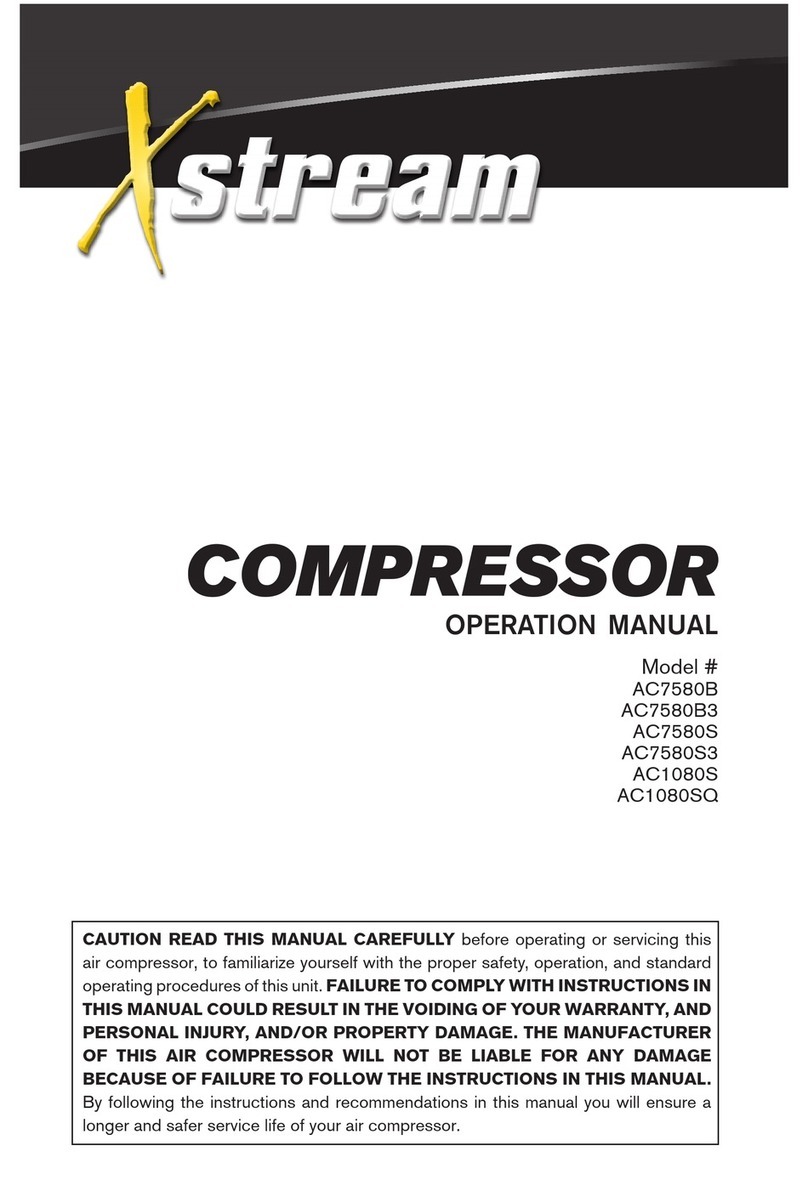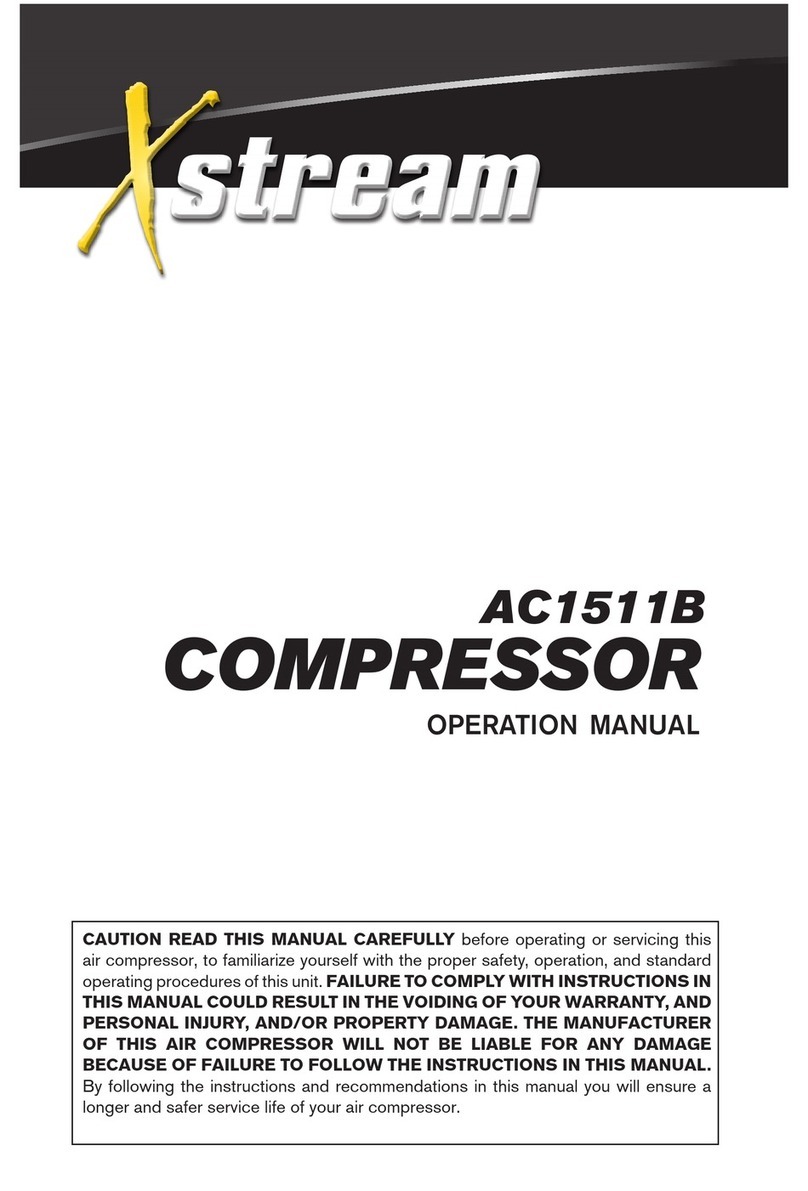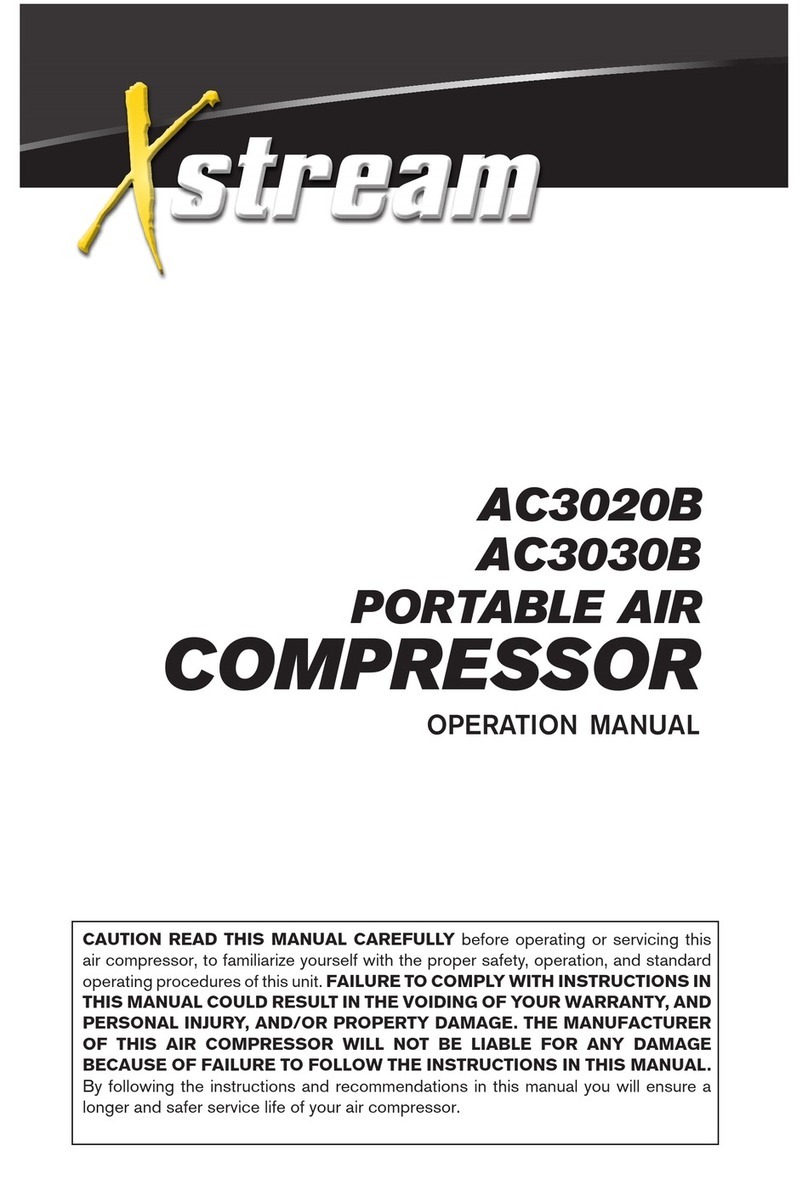Xstream AC5060B User manual

operation manual
AC5060B
AIR COMPRESSOR
CAUTION READ THIS MANUAL CAREFULLY before operating or servicing this
air compressor, to familiarize yourself with the proper safety, operation, and standard
operating procedures of this unit. FAILURE TO COMPLY WITH INSTRUCTIONS IN
THIS MANUAL COULD RESULT IN THE VOIDING OF YOUR WARRANTY, AND
PERSONAL INJURY, AND/OR PROPERTY DAMAGE. THE MANUFACTURER
OF THIS AIR COMPRESSOR WILL NOT BE LIABLE FOR ANY DAMAGE
BECAUSE OF FAILURE TO FOLLOW THE INSTRUCTIONS IN THIS MANUAL.
By following the instructions and recommendations in this manual you will ensure a
longer and safer service life of your air compressor.

2
table of contents
Safety
6 Safety Rules
7 Safety Warnings
Overview
11 Basic Air Compressor Components
Assembly
13 Assembling the Compressor
Installation
15 Installation Chart
16 Typical Installation
Controls
17 Compressor Controls
Electrical Power Requirements
18 Electrical Wiring
18 Main Power Panel
18 Main Power Disconnect Switch
18 Low Voltage Problems
19 Grounding Instructions
Break-In of the Pump
20 Break-In of the Pump
Operating Instructions
22 Daily Startup
22 Cold Weather Starting
22 Shutdown

3
table of contents
Maintenance
24 Draining the Tank
24 Checking the Oil
24 Changing the Oil
25 Belt Tension and Pulley Alignment
25 Adjusting Drive Belt Tension
25 Pulley Alignment
27 Cleaning the Air Filter
27 Checking the Relief Valve
27 Testing for Leaks
27 Storage
28 Maintenance Chart
Troubleshooting
29 Troubleshooting Chart
Glossary of Terms
31 Glossary of Terms
Parts List
32 Compressor
34 755 Pump Assembly
37 Parts Drawing

4
Using the Operator’s manual
The operating manual is an important part of your Compressor and
should be read thoroughly before initial use, and referred to often to make
sure adequate safety and service concerns are being addressed.
Reading the owner’s manual thoroughly will help avoid any personal injury
or damage to your pump. By knowing how best to operate this machine
you will be better positioned to show others who may also operate the
unit.
You can refer back to the manual at any time to help troubleshoot any
specific operating functions, so store it with the machine at all times.
Attention: Read through the complete
manual prior to the initial use of your
Compressor
introduction

5
product identification
Record Identification Numbers
Compressor
If you need to contact an Authorized Dealer or Customer Service
(1-866-770-1711) for information on servicing, always provide the
product model and identification numbers.
You will need to locate the model and serial number for the pump and
record the information in the places provided below.
Date of Purchase:
Dealer Name:
Dealer Phone:
Product Identification Numbers
Model Number:
Serial Number:

6
safety
The safety alert symbol ( ) is used with a signal word (DANGER,
CAUTION, WARNING), a pictorial and/or a safety message to alert
you to hazards.
DANGER indicates a hazard which, if not avoided, will result in death
or serious injury.
WARNING indicates a hazard which, if not avoided, could result in
death or serious injury.
CAUTION indicates a hazard which, if not avoided, might result in
minor or moderate injury.
NOTICE indicates a situation that could result in equipment damage.
Follow safety messages to avoid or reduce the risk of injury or
death.
Hazard Symbols and Meanings
Save these Instructions
SAFETY RULES
This is the safety alert symbol. It is used
to alert you to potential personal injury
hazards. Obey all safety messages that
follow this symbol to avoid possible injury
or death.
explosion
read manual
fire
toxic fumes hot surface
flying objects
moving parts
hearing risk
electric
shock

7
safety
WARNING
Risk of Fire or Explosion.
Never spray flammable liquids in confined area. It is normal for the
motor and pressure switch to produce sparks while operating. If sparks
come into contact with vapors from gasoline or other solvents, they may
ignite, causing fire or explosion. Always operate the compressor in a
well-ventilated area. Do not smoke while spraying. Do not spray where
sparks or flame are present. Keep compressor as far from spray area as
possible.
WARNING
Risk of Bursting.
• Do not weld, drill or modify the air tank of this compressor. Welding
or modifications on the air compressor tank can severely impair tank
strength and cause an extremely hazardous condition. Welding or
modifying the tank in any manner will void the warranty.
• Check the manufacturer’s maximum pressure rating for air tools and
accessories. Compressor outlet pressure must be regulated so as
to never exceed the maximum pressure rating of the tool. Relieve all
pressure through the hose before attaching or removing accessories.
• Do not adjust the relief valve for any reason. Doing so voids all
warranties. The relief valve has been pre-set at the factory for the
maximum pressure of this unit. Personal injury and/or property
damage may result if the valve is tampered with.
• Do not use plastic or pvc pipe for compressed air. Use only
galvanized steel pipe and fittings for compressed air distribution lines.

8
safety
WARNING
Risk of Electrical Shock.
Never use an electric air compressor outdoors when it is raining or on a
wet surface, as it may cause an electric shock.
WARNING
Risk of Injury.
This unit starts automatically. ALWAYS shut off the main power
disconnect, and bleed all pressure from the system before servicing
the compressor, and when the compressor is not in use. Do not use
the unit with the shrouds or belt guard removed. Serious injury could
occur from contact with moving parts. Stay alert and watch what you
are doing when operating the compressor. Do not use the compressor
while tired or under the influence of drugs or alcohol.
WARNING
Risk of Burns.
High temperatures are generated by the pump and manifold. To prevent
burns or other injuries, DO NOT touch the pump, manifold or transfer
tube while the pump is running. Allow them to cool before handling or
servicing. Keep children away from the compressor at all times.
WARNING
Risk of Breathing.
Be certain to read all labels when you are spraying paints or toxic ma-
terials, and follow the safety instructions. Use a respirator mask if there
is a chance of inhaling anything you are spraying. Read all instructions
and be sure that your respirator mask will protect you. Never directly
inhale the compressed air produced by a compressor it is not suitable
for breathing purposes.

9
safety
WARNING
Risk of Eye Injury.
Always wear ANSI Z87.1 approved safety goggles when using an air
compressor. Never point any nozzle or sprayer toward a person or
any part of the body. Equipment can cause serious injury if the spray
penetrates the skin.
WARNING
CALIFORNIA PROPOSITION 65 WARNING:
This product contains chemicals known to the State of California to
cause cancer, birth defects and/or reproductive harm.
WARNING
Risk of Hearing.
Always wear hearing protection when using an air compressor. Failure
to do so may result in hearing loss.
WARNING
Wash hands after handling. The power cord on this
product contains lead, a chemical known to the State
of California to cause cancer, and birth defects or other
reproductive harm.
NOTICE
• ELECTRICAL WIRING. Refer to the air compressor’s serial label for
the unit’s voltage and amperage requirements. Ensure that all wiring
is done by a licensed electrician, in accordance with the National
Electrical code.

10
safety
CAUTION
1. Drain the moisture from the tank on a daily basis. A clean, dry tank
will help prevent corrosion.
2. Pull the pressure relief valve ring daily to ensure that the valve
is functioning properly, and to clear the valve of any possible
obstructions.
3. To provide proper ventilation for cooling, the compressor must be
kept a minimum of 12 inches (31 cm) from the nearest wall, in a
well-ventilated area.
4. To prevent damage to tank and compressor on stationary models,
the tank must be shimmed to the pump base is level within 1/8” to
distribute oil properly. All feet must be supported, shimming where
necessary, prior to attaching to the floor. Fasten all feet to floor. We
also recommend the use of vibration pads (094-0137) under tank
feet.
5. Fasten the compressor down securely if transporting is necessary.
Pressure must be released from the tank before transporting.
6. Protect the air hose from damage and puncture. Inspect them
weekly for weak or worn spots, and replace if necessary.
7. To reduce the risk of electric shock, do not expose to rain. Store
indoors.
Table of contents
Other Xstream Air Compressor manuals




















